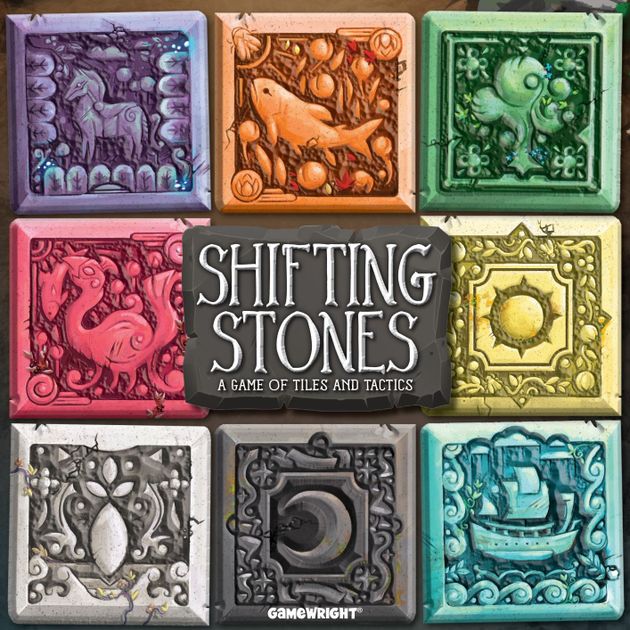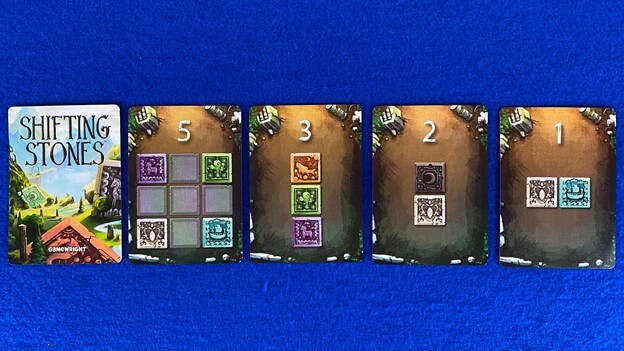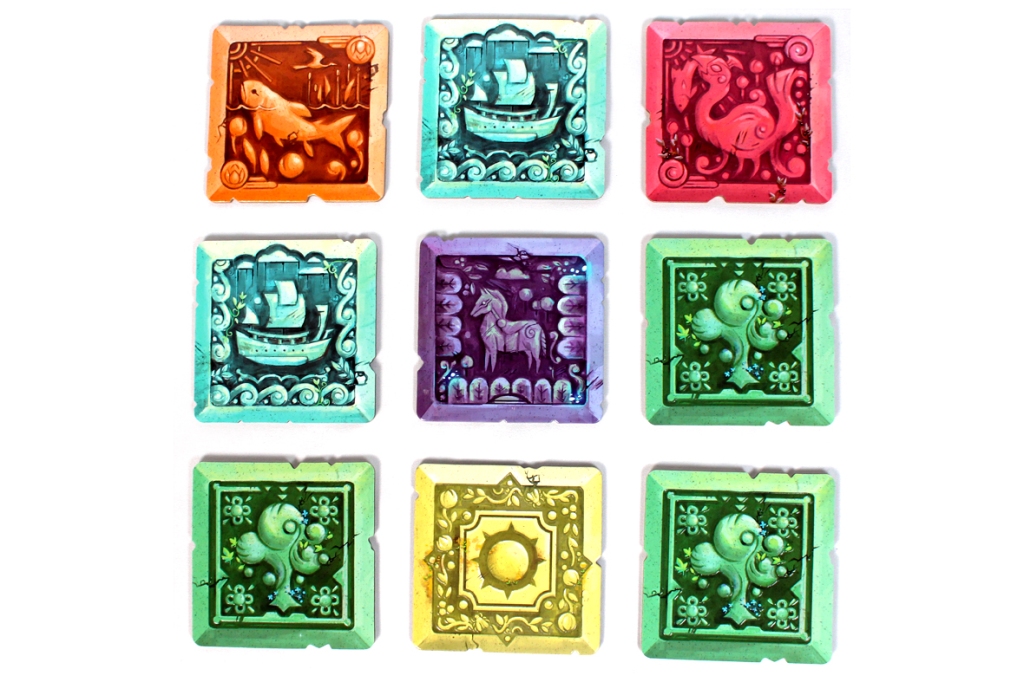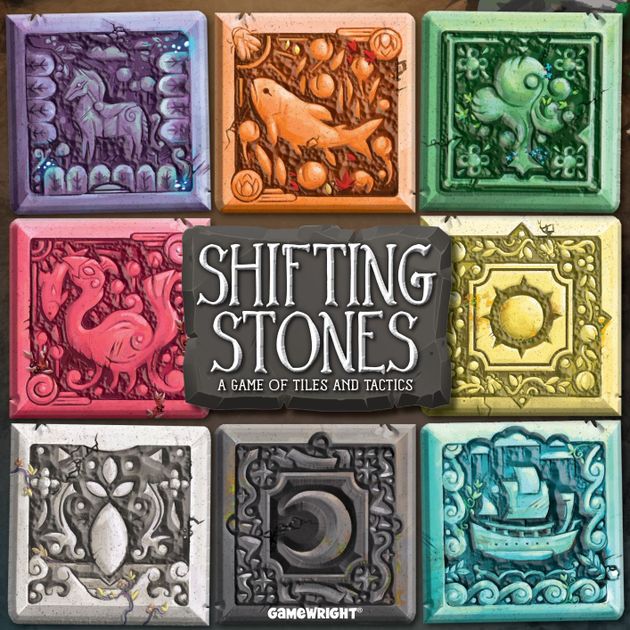 Easy to learn, with endless opportunities to develop higher level skills and strategies, Shifting Stones is great fun for 1-5 players, aged eight and above. Shifting Stones is a fantastic choice for those just starting to explore board games, or for those looking to take their abilities to the next stage. In Shifting Stones, players swap tiles on a 3×3 grid in order to score points by recreating the different patterns pictured on cards in their hand, with various point values and difficulties involved. By using strategy and a sharp eye, try and outwit your opponents each turn to score the most points before someone activates the end game trigger. Will you work fast and furiously to secure lots of ‘easy’ points, or carefully plan ahead and surprise your opponent with a big score? The game ends when the end game trigger requirements are met, meaning players can control and adjust the speed of the game by the moves they make. To find a winner, players add up the total score of the pattern cards they completed and the player with the most points wins. But be careful, there are several ways to score points in Shifting Stones!
Easy to learn, with endless opportunities to develop higher level skills and strategies, Shifting Stones is great fun for 1-5 players, aged eight and above. Shifting Stones is a fantastic choice for those just starting to explore board games, or for those looking to take their abilities to the next stage. In Shifting Stones, players swap tiles on a 3×3 grid in order to score points by recreating the different patterns pictured on cards in their hand, with various point values and difficulties involved. By using strategy and a sharp eye, try and outwit your opponents each turn to score the most points before someone activates the end game trigger. Will you work fast and furiously to secure lots of ‘easy’ points, or carefully plan ahead and surprise your opponent with a big score? The game ends when the end game trigger requirements are met, meaning players can control and adjust the speed of the game by the moves they make. To find a winner, players add up the total score of the pattern cards they completed and the player with the most points wins. But be careful, there are several ways to score points in Shifting Stones!
Game Instructions:
The Grid

To begin, orient the board in a direction that all players agree on, this is important as the game won’t work if players are working to complete patterns from completely different points of view or perspectives. Once you have agreed on which way to orient the board, arrange 9 coloured tiles in a 3×3 grid, making sure all of the images are facing the same direction (it might help call the agreed top of the grid North as ‘up’ will look differently to each player around the board).

Tile Guide Cards
Next, Give each player one of the two-sided tile guide cards. These cards let you know what is on the other side of the stone currently facing up and also have a description of the different turn actions, use this card as a way to make sure the move you are planning can be done, or even help plan your next move. Before beginning, make sure that one player receives the tile guide card with the black background (the rest are grey), this will be the player who starts the game.
Pattern Cards
Shuffle the deck of pattern cards until you are sure they are all well mixed. Place the deck at the top (north) of your 3×3 grid face down and leave a space next to your deck for a discard pile. Deal each player four pattern cards, these cards are your ‘hand’. Keep your hand secret from other players, If your opponent knows what patterns you are trying to make they may try and block you and stop you scoring points! The numbers at the top of the card let you know how many points that pattern is worth. The picture on the card shows you what pattern you need to create on the 3×3 grid in order to score points with that card. The lower the number, the less points. However, a lower number also means the pattern is easier to complete.

Taking A Turn
Starting with the player who was dealt the reference card with the black background, each play takes their turn. On your turn there are several choices to make. First, decide which pattern from your hand you are going to try and make. Remember to look at the 3×3 grid and then choose a pattern card that you think you can make this turn. Once you have decided which pattern you want to try and complete you can do a couple of things.

Shifting Stones
On their turn, a player can swap a stone tile with the one next to it either horizontally or vertically (left and right or up and down), but not diagonally. For example, a player could shift the orange stone shown in the example 3×3 grid with either of the blue stones, but they cannot shift the orange stone with the purple stone.
A player can also flip one of the stones on the grid to reveal the stone on the other side of the tile (this is where that tile reference guide really comes in handy!). However, every time a player shifts or flips a stone tile, they must place one pattern card from their hand in the discard pile.

Ending Or Skipping Your Turn
Once you have flipped, shifted and scored as much as you can collect the points by placing your completed pattern cards down in front of you to show everyone you have completed them.. Alternatively, you can choose to skip you turn completely in order to pick up two more pattern cards, bringing your hand to six pattern cards.
Ending The Game
The game end when a player reaches the “End- Game Trigger”. The trigger depends on how many people are playing. To find out who has won, each player adds up the total value of their completed pattern cards. But wait! There’s more, the person who completed the most cards worth one point gets a bonus of three points!
Game Trigger”. The trigger depends on how many people are playing. To find out who has won, each player adds up the total value of their completed pattern cards. But wait! There’s more, the person who completed the most cards worth one point gets a bonus of three points!
